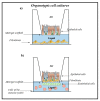Impact of Air Pollution in Airway Diseases: Role of the Epithelial Cells (Cell Models and Biomarkers)
- PMID: 35269941
- PMCID: PMC8911203
- DOI: 10.3390/ijms23052799
Impact of Air Pollution in Airway Diseases: Role of the Epithelial Cells (Cell Models and Biomarkers)
Abstract
Biomedical research is multidisciplinary and often uses integrated approaches performing different experimental models with complementary functions. This approach is important to understand the pathogenetic mechanisms concerning the effects of environmental pollution on human health. The biological activity of the substances is investigated at least to three levels using molecular, cellular, and human tissue models. Each of these is able to give specific answers to experimental problems. A scientific approach, using biological methods (wet lab), cell cultures (cell lines or primary), isolated organs (three-dimensional cell cultures of primary epithelial cells), and animal organisms, including the human body, aimed to understand the effects of air pollution on the onset of diseases of the respiratory system. Biological methods are divided into three complementary models: in vitro, ex vivo, and in vivo. In vitro experiments do not require the use of whole organisms (in vivo study), while ex vivo experiments use isolated organs or parts of organs. The concept of complementarity and the informatic support are useful tools to organize, analyze, and interpret experimental data, with the aim of discussing scientific notions with objectivity and rationality in biology and medicine. In this scenario, the integrated and complementary use of different experimental models is important to obtain useful and global information that allows us to identify the effect of inhaled pollutants on the incidence of respiratory diseases in the exposed population. In this review, we focused our attention on the impact of air pollution in airway diseases with a rapid and descriptive analysis on the role of epithelium and on the experimental cell models useful to study the effect of toxicants on epithelial cells.
Keywords: airway diseases; environmental pollution; epithelial cells; exposome; system biology.
Conflict of interest statement
The authors of the paper declare that they have no competing interests for this study.
Figures






References
-
- Ashfaq A., Sharma P. Environmental effects of air pollution and application of engineered methods to combat the problem. J. Indust. Pollut. Control. 2012;29:25–28.
-
- Szyszkowicz M., Kousha T., Valacchi G. Ambient air pollution and emergency department visits for skin conditions. Glob. Dermatol. 2016;3:323–329. doi: 10.15761/GOD.1000184. - DOI
Publication types
MeSH terms
Substances
LinkOut - more resources
Full Text Sources
Medical
Miscellaneous

